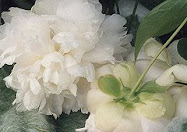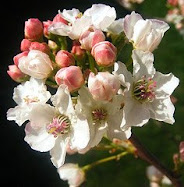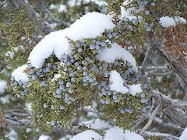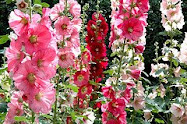 Two tomatoes, four radishes. Therein is the sum total of fresh produce yielded to date by the small vegetable patch put in this summer. The patch was sown in early June with one row each of seeds of sweet green pepper, radishes and cucumbers, and two six-inch high Early Girl tomato plants. Then along came, according to weather records, the coolest, most rainy Michigan summer in about one hundred years.
Two tomatoes, four radishes. Therein is the sum total of fresh produce yielded to date by the small vegetable patch put in this summer. The patch was sown in early June with one row each of seeds of sweet green pepper, radishes and cucumbers, and two six-inch high Early Girl tomato plants. Then along came, according to weather records, the coolest, most rainy Michigan summer in about one hundred years.The tomato plants gained only about six new inches in upward growth all summer, and each managed to generate only one tomato. These fruits are still smaller than a tennis ball and still green, though one began to show tracings of a pink blush this week, so they should ripen enough for consumption by mid-September. Truth be told, the minimal yield and growth probably cannot be blamed solely upon the weather, although that did play its inauspicious part. Three doors down the block, my neighbor's tomato plants stand a much healthier four-feet high, with lots of tomatoes, albeit also small and still stubbornly green. The neighbor fertilized her seedlings, I alas did not, mistakenly trusting in nature and composted manure to feed them sufficiently, and having a reluctance to introduce and use foreign chemicals, even organic ones, in the garden.
The bell peppers sprouted, and tiny sprouts they remain to this day, apparently having decided this was all the maturation they could or would accomplish under the cool, cloudy skies. The cucumbers initially showed great promise, sprouting within a couple days of seeding and developing into a leafy, healthy row of young plants with plenty of yellow flowers. Beyond the surge of those first weeks they simply stopped, and nary even a single cucumber has emerged.
As for the radishes, the plants bounded up, green and thick with leaves, put forth a sweet display of soft pink flower heads, and then bolted straight into seed production while the nascent radishes beneath the soil got no bigger than a fingernail and no wider than a pencil. My guess (and that's all it is since my agriculture know-how is obviously sorely lacking), is that the row should have been thinned rather radically at the sprout stage to give those left more elbow room, as it were, and as advised on the seed packet instructions. I'm cowardly and disinclined when it comes to culling eager young sprouts, and did not do so. The four little radishes salvaged, cleaned up and eaten had a great, pungent and pronounced flavor, but taken together added up to not even a whole mouthful. As far as this first foray into vegetable gardening goes, let's just say it's very fortuitous farmer's markets abound in these northern Michigan parts.
Every year without fail or hesitancy, Mother Nature redesigns the garden laid out for the summer, sometimes in ways to the gardener's liking, sometimes decidedly not. In the present season, besides stunting the vegetables in their infancy, her less favored, wholesale, scatter-shot propagation ran to invasive ground pine throughout the plot, from woodchip-covered unplowed ground to flower beds; the apparent assassination of half a dozen of last year's hardy (ha!) chrysanthemums; spotted knapweed, white campion, common mullein and tough-as-nails weed grasses everywhere; and the self-seeding replication of one variegated sage into a half-dozen new plants, volunteering round and about the flower bed that formerly housed most of the chrysanthemum victims.
On the plus side, to give her due credit, Mother Nature took kindly to the bunches of extraneous lavender flowers pruned off last August and spread about the yard as green mulch, giving the garden this summer a dozen or more new, surprise lavender plants now on the go, and viable enough for transplanting to any bed or container which could use filling out. Likewise, nature brought the garden random new outcroppings of pretty little snow-in-summer and violas; ten or twelve big, confident, flower-bedecked stands of the always beguiling, olden-times evocative Queen Anne's lace; a half-dozen or so plants of the late summer showgirl, black-eyed Susan; and a real plethora of decorative hoary alyssum and ox-eye daisies. A watchful eye does need to be kept on these wildflower volunteers, as given their breeding habits they are but the thin edge of the wedge, and allowed half a chance and a free hand, will gladly migrate and reproduce throughout the whole yard, becoming a bit too much of an otherwise mostly good thing.
The British gardener and writer Hugh Johnson has said, “no two days are the same in one garden.” To forestall disappointment, a similar expectation really ought to inform our approach to each new season in the garden, wherein the standouts and fond companions of last year may or may not return for another fine go-round in subsequent summers. The garden is, after all, just a microcosm of the beautiful, ephemeral, temporal Earth we inhabit, nothing here is permanent nor certain except constant change. Every summer surely brings losses to the garden, false starts and failures. Fortunately for the gardener, it just as surely bestows gains, surprise packages and unexpected success stories. And that's what keeps the gardener pulling on the tattered old straw hat, hitching up the dungarees, and heading out to get down, dirty and atwirl with nature, year after year.









2 comments:
you doubled my tomatoe harvest show off!
Thank you, Bart, for making me look twice as good.
Post a Comment